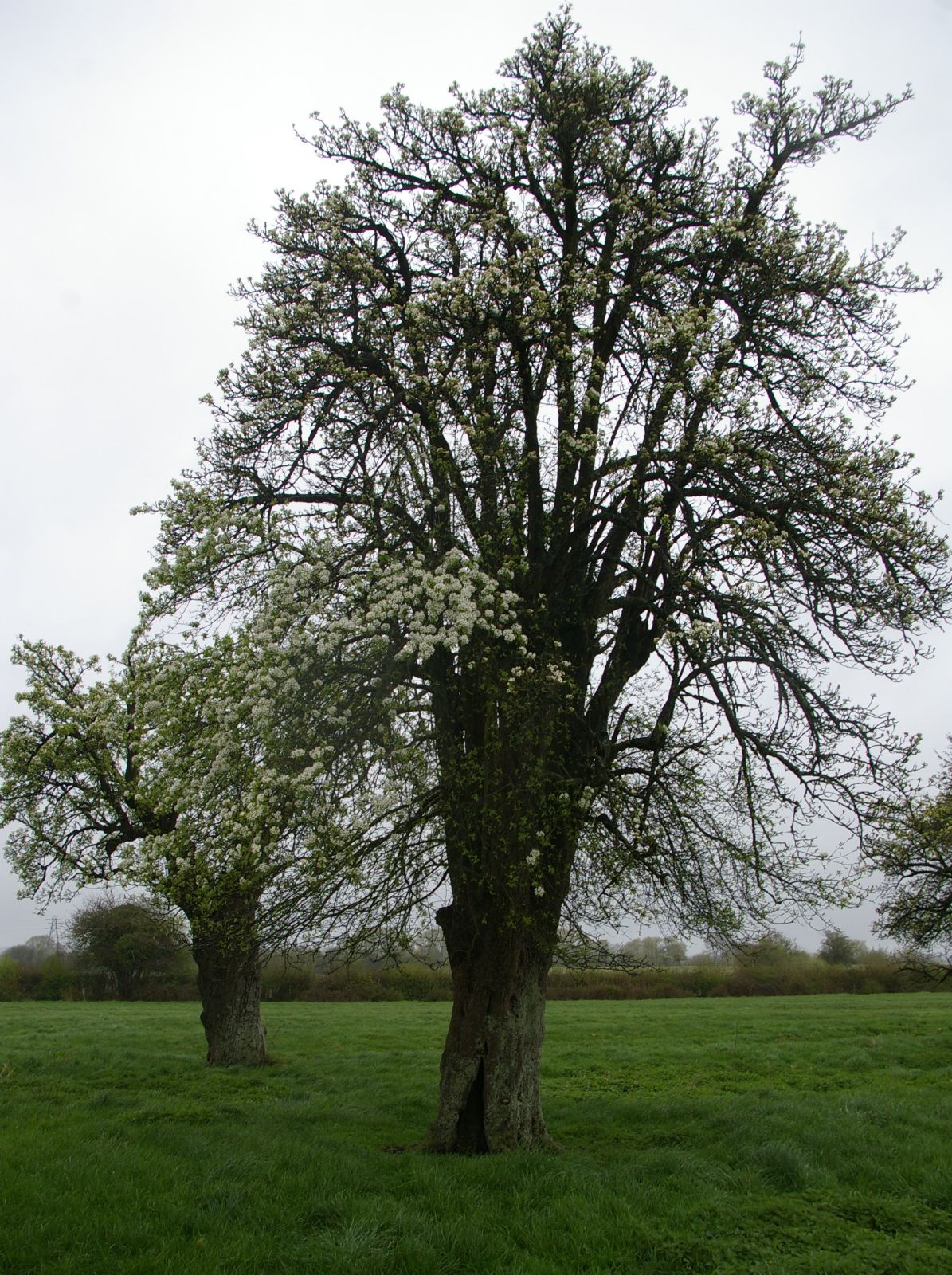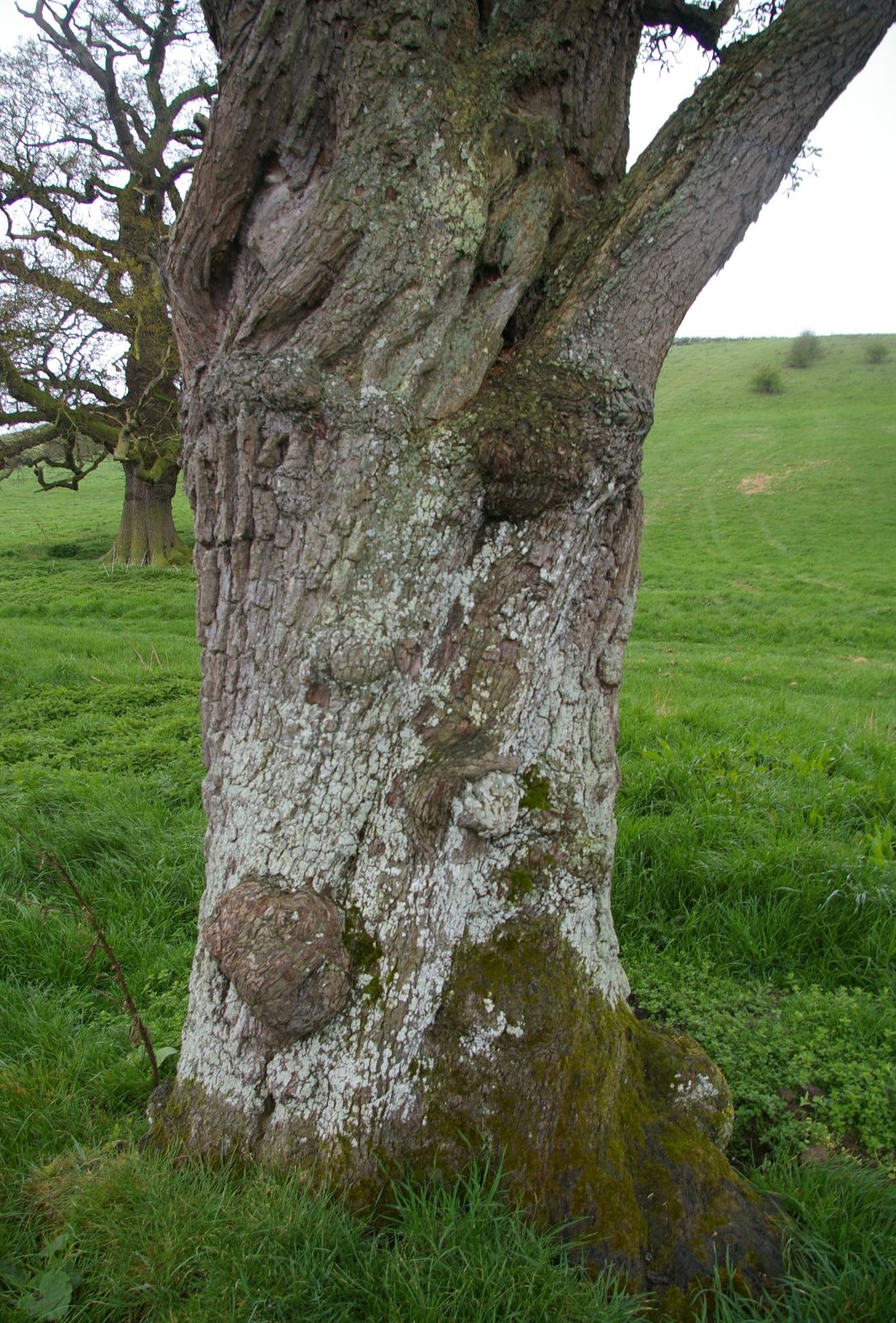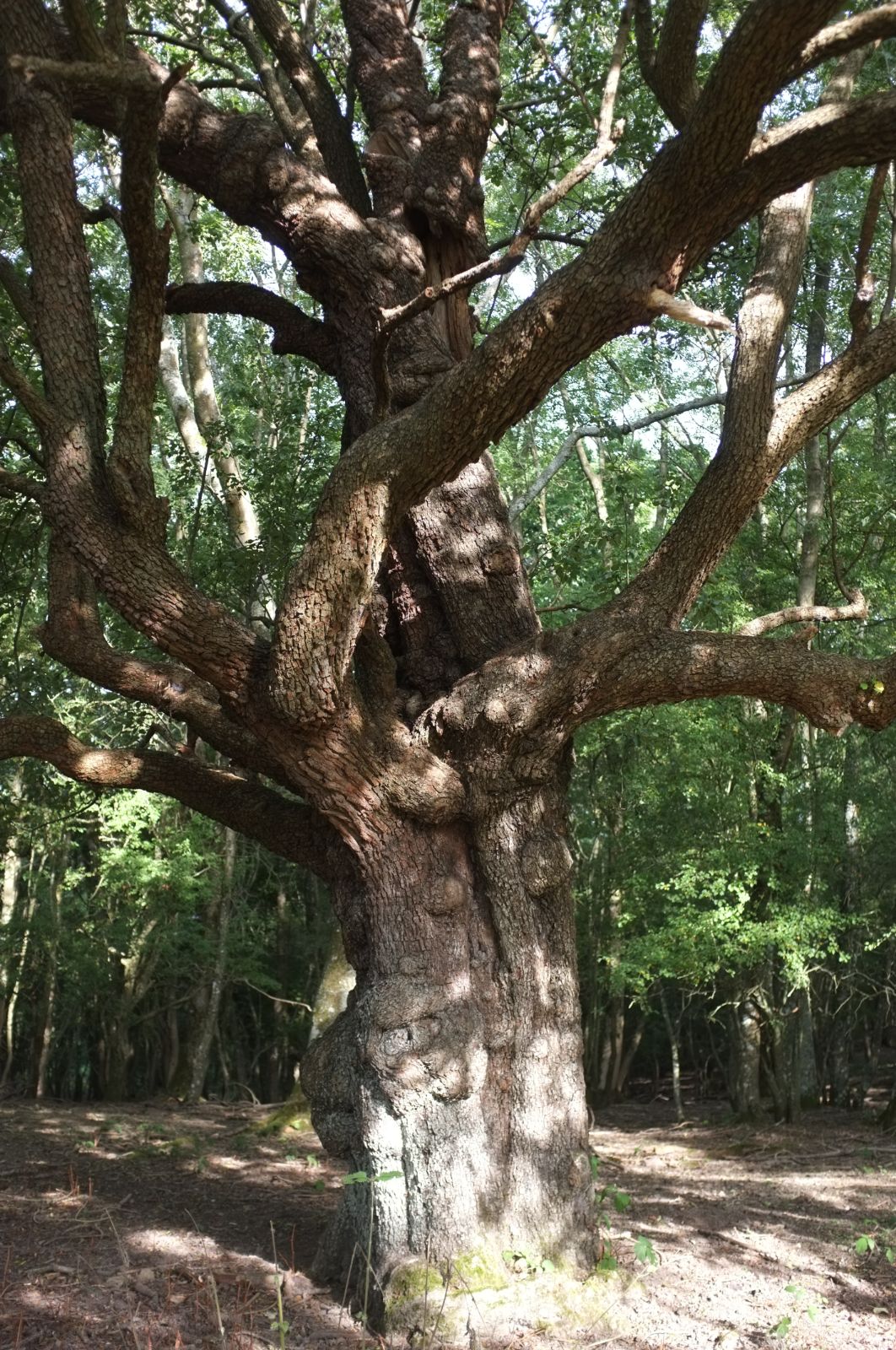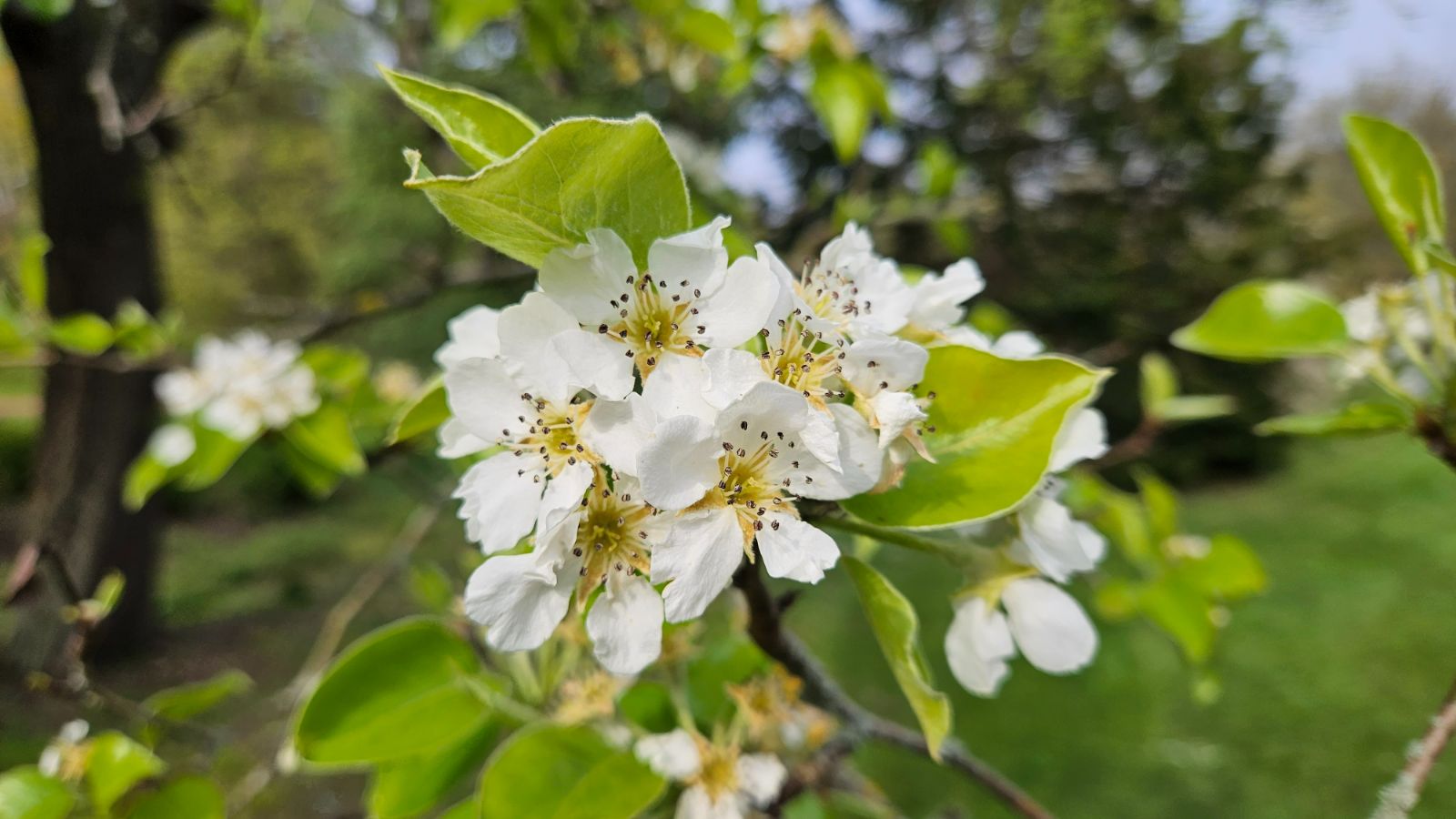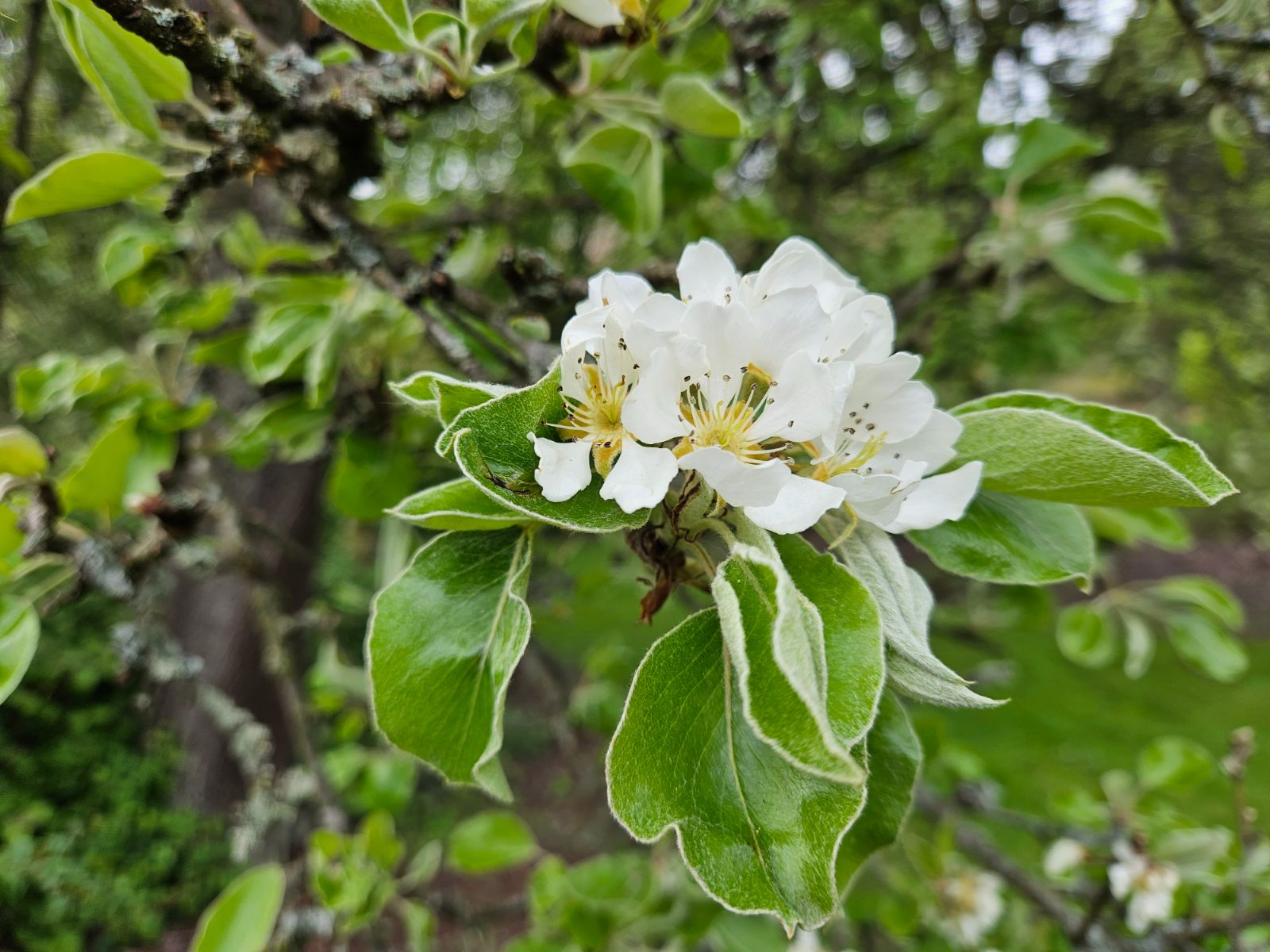Pyrus communis
Credits
Article from Bean's Trees and Shrubs Hardy in the British Isles
Article from New Trees by John Grimshaw & Ross Bayton
Recommended citation
'Pyrus communis' from the website Trees and Shrubs Online (treesandshrubsonline.
Infraspecifics
A deciduous tree, usually 30 to 40, occasionally as much as 60 ft high, with a trunk 3 ft through; branches forming short stiff spurs, sometimes spiny. Leaves variable, from ovate, heart-shaped and oval, to almost round; from 1 in. to 4 in. long, up to 2 in. wide, very finely round-toothed or entire; stalk slender, 1 to 2 in. long; the leaves are variable in their downiness, but are either glabrous from the beginning or become nearly or quite so later, and glossy green. Flowers white, 1 to 11⁄2 in. across, produced in corymbs 2 to 3 in. across, each flower on a more or less woolly stalk 1⁄2 to 11⁄2 in. long. Fruits top-shaped or rounded, with a tapering or rounded base.
P. communis, in the broad sense, is a complex species and partly of hybrid origin. It comprises the wild pear, which by selection and by crossing with Other species (probably P. nivalis and P. cordata) gave rise to the orchard pears (P. communis var. culta DC.). These in turn have frequently escaped back into the wild and become so intermingled and interbred with the ancestral wild pear that it is no longer possible to distinguish it from its naturalised offspring. All that can be said is that wild or seemingly wild pears as described above occur over much of Europe, including the British Isles.
In gardens the wild pear has not much claim to notice. Its graceful, often pendulous branches and large crops of flowers are beautiful, but the garden varieties are just as much so, and give useful fruits as well. The common pear (both wild and cultivated) is long-lived and yields an excellent timber, heavy, tough, and durable, which, however, is not plentiful enough to be of much importance in commerce.
From the Supplement (Vol. V)
cv. ‘Beech Hill’. – The original tree was noticed by the late Rowland Jackman growing in a hedgerow not far from his nursery.
From New Trees
Pyrus communis L.
Common Pear
This species was described by Bean (B448) and Krüssmann (K74). Identifying subspecies of the Common Pear is difficult. They are delimited partly by geography, so cultivated accessions with no collection data often cannot be named. In addition, the Domestic Pear (P. communis subsp. sativa (Lam. & DC.) Asch. & Gr.) occurs within the natural range of several other subspecies and forms hybrids with them. Pyrus cordata has also to be fitted into the equation, and it seems likely that some of the smaller-fruited taxa may be related to this. A key to the subspecies of Pyrus communis, modified from those of Browicz (1972) and Maire (1980), is given below.
| 1a. | Branchlets unarmed; leaves large, to 7 × 5 cm; fruits large, > 5 cm long, solitary, with soft flesh; in cultivation in temperate areas around the world (the Domestic Pear) | subsp. sativa |
| 1b. | Branchlets spiny; leaves small, to 3 × 3 cm; fruits small, up to 4 cm long, in groups of two to six, with hard flesh | 2 |
| 2a. | Distribution in Europe, western and central Asia | 3 |
| 2b. | Distribution in North Africa | 4 |
| 3a. | Leaves crenate-serrate or subentire, not ciliate; Europe | subsp. communis |
| 3b. | Leaves entire, ciliate; Greece (Thrace), Turkey (north and southwest Anatolia), Russian Federation (Caucasus), Ukraine (Crimea) | subsp. caucasica |
| 4a. | Leaves largely ovate-cordate; fruit subglobose to pyriform, 2–2.5 cm long, peduncle robust; seeds large, 0.8 × 0.7 cm | subsp. mamorensis |
| 4b. | Leaves not cordate; fruit subglobose to obovate, 1–1.3 cm long, peduncle slender; seeds small, ~0.4 cm long | 5 |
| 5a. | Leaves subcircular or largely ovate, apex short-acuminate; fruit subglobose, four to five locules | subsp. longipes |
| 5b. | Leaves ovate-oblong or oblong, apex long-acuminate; fruit ± obovate, two to three (to four) locules | subsp. gharbiana |
'Beech Hill'
A tree of spire-like habit.P cordata Desv.
Synonyms
P. communis var. cordata (Desv.) Briggs
P. communis var. briggsii Syme
P cossonii Rehd.
Synonyms
P. longipes Coss. & Durieu, not Poit. & Turp.
P. communis var. longipes (Coss. & Durieu) Henry
P syriaca Boiss
This species is related to the wild pear of Europe, from which it differs in its relatively narrower leaves, which are ovate or ovate-lanceolate, up to 2 in. long and 1 in. or slightly more wide. The fruits are smaller, about {3/4} in. wide. It occurs wild from Turkey and Cyprus to the Caucasus, Iraq, and Persia.
subsp. caucasica (Fed.) Browicz
Common Names
Caucasian Pear
Subsp. caucasica is a tree to 25 m, with spiny branches and entire, ciliate leaves. The fruits are brown and globose-turbinate. Terpó & Franco 1968, Browicz 1972. Distribution GREECE: Thrace; RUSSIAN FEDERATION: Caucasus; TURKEY: northern and southwest Anatolia; UKRAINE: Crimea. Habitat Forests. USDA Hardiness Zone 5. Conservation status Not evaluated. Illustration NT686.
This is the easternmost version of Pyrus communis, and does not differ greatly from western European representatives except in its ciliate leaf margins. Like them it is a fine, densely clad, long-lived tree. It is not common in general cultivation but is grown by research institutions such as the National Clonal Germplasm Repository, Corvallis, Oregon, where there are numerous accessions of known wild origin (National Germplasm Repository 2008). There is a magnificent specimen of unknown origin at the Hillier Gardens, measured at 14.1 m (58 cm at 1 m) in 2008, with several principal vertical stems from a low trunk, forming a broad dark green crown. This was liberally furnished with bright green, very unripe pears when seen in June 2007. Mature trees are occasional in arboreta across our area, but young plants are also grown in some American collections: at the Morton Arboretum, for example, from seed obtained from the Midwest Plant Collecting Collaborative 2000 Republic of Georgia Contract Collection, gathered in the Imereti Region, Georgia. Like many other good plants from the Caucasus, it should be ideally suited to US Midwestern and continental European conditions.
subsp. gharbiana (Trabut) Maire
Subsp. gharbiana has small, obovate fruits on slender pedicels, with two to three locules (rarely four). The flowering corymbs comprise 9–15 rather small flowers (~2.25 cm diameter). Maire 1980. Distribution MOROCCO: Atlas Mts. Habitat Calcareous mountains. USDA Hardiness Zone 5–6. Conservation status Not evaluated. Illustration Maire 1980.
Subsp. gharbiana, which appears to be a small-fruited representative of the Pyrus communis alliance from North Africa, is included here mainly for completeness, as it seems to be principally grown by institutions with a particular interest in wild fruit genotypes. The only specimen located in the United Kingdom is at Kew, received in 1986 from the now-defunct Long Ashton Research Station. Several accessions of material of wild origin are maintained at the National Clonal Germplasm Repository, Corvallis (National Germplasm Repository 2008), and it may also be grown in specialist collections of fruit trees.
subsp. longipes (Cosson & Durand) Maire
Common Names
Algerian Pear
Synonyms
P. cossonii Rehder
Subsp. longipes has subglobose fruits, slightly larger than in subsp. gharbiana, on slender pedicels, with four to five locules. Maire 1980. Distribution ALGERIA. Habitat Calcareous mountains. USDA Hardiness Zone 8–9. Conservation status Not evaluated. Illustration Maire 1980. Cross-references B449, K75 (both as P. cossonii).
This taxon is relatively well known in cultivation as Pyrus cossonii, and occasionally as P. longipes. TROBI has recorded numerous specimens in gardens throughout the United Kingdom, the champion being a 20 m tree measured at Collingwood Grange, Benenden, Kent in 1995.



